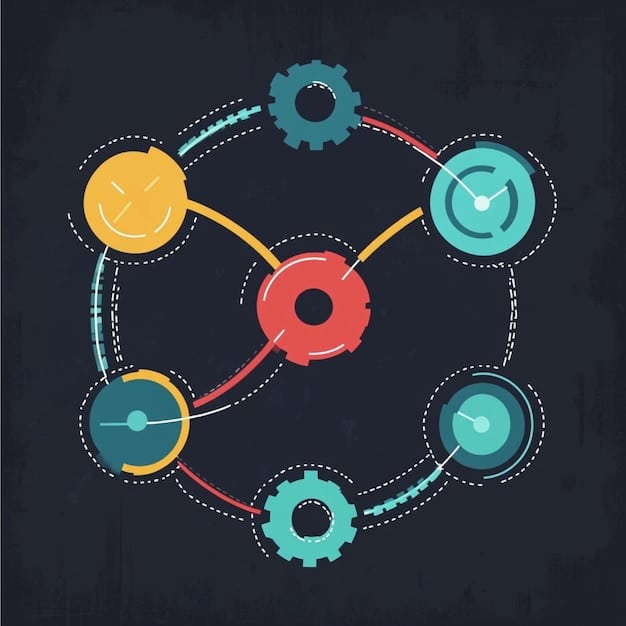Project Management in 2025: Agile & Scrum Mastery

Successful project management in 2025 demands a profound understanding and application of Agile and Scrum methodologies, which are pivotal for navigating complex, rapidly evolving project landscapes and delivering value efficiently.
The landscape of project management is in constant flux, driven by technological advancements, shifting market demands, and the imperative for faster time-to-market. In this dynamic environment, the ability to adapt, innovate, and deliver with precision has become paramount. For those looking to thrive in the coming years, mastering Project Management in 2025: Mastering Agile and Scrum Methodologies isn’t just an advantage; it’s a fundamental necessity.
The Evolving Role of the Project Manager in 2025
The traditional project manager, once primarily focused on rigid planning and sequential execution, is rapidly transforming into a dynamic facilitator and strategic leader. This evolution is not merely superficial; it fundamentally alters the required skill set and mindset. Project managers of 2025 are less about command and control and more about enablement and empowerment. They foster self-organizing teams, remove impediments, and cultivate a culture of continuous improvement.
This shift reflects a broader organizational push towards agility and adaptability. As businesses face unprecedented rates of change, they need project leadership that can pivot quickly, embrace uncertainty, and deliver incremental value. This means moving beyond static Gantt charts towards iterative planning and adaptive execution, where feedback loops are constant and adjustments are woven into the very fabric of the project.
Beyond Traditional Boundaries: New Responsibilities
In 2025, the project manager’s responsibilities extend far beyond the confines of a project schedule. They are increasingly involved in:
- Strategic Alignment: Ensuring projects directly contribute to overarching business goals and vision.
- Stakeholder Engagement: Actively managing expectations and fostering collaboration across all levels, from team members to executive leadership.
- Technological Acumen: Understanding and leveraging emerging tools and platforms, including AI-driven analytics and automation, to enhance project efficiency.
- Risk and Opportunity Management: Proactively identifying not just threats, but also unforeseen opportunities that can emerge during dynamic projects.
Moreover, the emphasis shifts from individual heroics to collective intelligence. A modern project manager facilitates an environment where team members feel safe to experiment, learn from failures, and contribute their diverse perspectives. The focus is on creating resilient teams that can navigate ambiguity and deliver consistent results, rather than solely relying on the manager’s individual directives.
Ultimately, the project manager in 2025 acts as a bridge between strategic objectives and operational realities, translating complex visions into actionable steps while fostering a culture of innovation and collaboration. Their success is measured not just by project completion, but by the tangible business value delivered and the continuous growth of their teams.
Agile Methodologies: Foundation for Future Success
Agile is no longer just a buzzword; it’s the operational backbone for organizations striving for competitive advantage in 2025. This set of principles, articulated in the Agile Manifesto, champions iterative development, flexible responses to change, and constant collaboration. Unlike rigid, predictive approaches, Agile embraces unpredictability, positioning it as a fundamental methodology for handling complex, knowledge-intensive work.
The core tenets of Agile—individuals and interactions over processes and tools, working software over comprehensive documentation, customer collaboration over contract negotiation, and responding to change over following a plan—remain as relevant as ever. However, their application has matured, extending beyond software development into various business functions, from marketing to human resources.

Key Principles Applied in Practice
Implementing Agile effectively in 2025 demands a deep understanding of its foundational principles and how they translate into daily operations. This involves a shift in organizational culture and individual mindset. Iterative cycles, or sprints, become the standard, allowing for continuous feedback and refinement. Early and continuous delivery of valuable product increments is prioritized, ensuring that customer needs are met consistently.
Consider the emphasis on customer collaboration. This isn’t just about gathering requirements at the outset; it’s about embedding the customer in the development process, involving them in reviews, and directly incorporating their feedback into each iteration. This close relationship ensures that the final product truly meets evolving market demands and user expectations.
Agile teams are inherently self-organizing, meaning they have the autonomy to decide the best way to accomplish their work. This empowers team members, fostering a sense of ownership and increasing motivation. The role of management shifts from dictating tasks to providing guidance, support, and removing obstacles, allowing teams to flourish and innovate.
Furthermore, Agile emphasizes simplicity—the art of maximizing the amount of work not done. This translates into focusing on delivering the most valuable features first, avoiding unnecessary complexity, and maintaining sustainable pace for development. This approach not only optimizes resource allocation but also contributes to higher quality outputs and reduced project risk.
Adopting Agile isn’t a one-time process; it’s a continuous journey of learning and adaptation. Organizations in 2025 are constantly refining their Agile practices, leveraging new tools and insights to enhance their flexibility and responsiveness in a rapidly changing business environment. It’s about building a learning organization that can effectively navigate complex challenges.
Scrum Methodology: Agile in Action
Scrum is the most widely adopted framework for implementing Agile principles, particularly prevalent in 2025 due to its simplicity, effectiveness, and adaptability. It provides a lightweight structure for teams to manage complex work through iterative and incremental cycles known as “sprints.” A typical sprint lasts two to four weeks, during which a “Done” increment of product is created, ready for review. This consistent rhythm enables rapid feedback and continuous adjustment.
At its heart, Scrum embodies empirical process control, meaning decisions are based on observation and experimentation rather than detailed upfront planning. Transparency, inspection, and adaptation are its pillars. Teams regularly inspect their progress towards a Sprint Goal and adapt their process and output, ensuring alignment with user needs and business objectives. This iterative loop minimizes risk and maximizes value delivery.
Roles, Events, and Artifacts in 2025’s Scrum Landscape
Understanding Scrum involves grasping its defined roles, events, and artifacts, each contributing to effective project delivery:
Scrum Roles:
- Product Owner: Responsible for maximizing the value of the product resulting from the work of the Development Team. They manage the Product Backlog.
- Scrum Master: Facilitates Scrum, ensuring the team adheres to Scrum values and practices. They remove impediments and coach the team.
- Development Team: Self-organorganizing and cross-functional, responsible for delivering a “Done” increment of product each Sprint.
These roles are designed to foster collaboration and accountability, moving away from hierarchical command structures. The Product Owner ensures the team builds the right product, the Scrum Master ensures they build it right, and the Development Team brings it to life. This clear delineation minimizes confusion and optimizes workflow.
Scrum Events (Meetings):
- Sprint Planning: The team defines what will be built in the upcoming Sprint and how.
- Daily Scrum: A brief daily meeting for the Development Team to synchronize activities and plan for the next 24 hours.
- Sprint Review: The team demonstrates the “Done” increment to stakeholders and gathers feedback.
- Sprint Retrospective: The team inspects how the last Sprint went regarding individuals, interactions, processes, and tools, and plans improvements for the next Sprint.
These events provide rhythm and structure to the daily work, ensuring transparency and opportunities for continuous adaptation. They are time-boxed, meaning they have a maximum duration, promoting efficiency and focus.
Scrum Artifacts:
- Product Backlog: An ordered list of everything that might be needed in the product.
- Sprint Backlog: The set of Product Backlog items selected for the Sprint, plus a plan for delivering the product increment and realizing the Sprint Goal.
- Product Increment: The “Done” work from the current Sprint combined with the increments of all previous Sprints.
These artifacts maximize transparency of key information, allowing everyone to have a shared understanding of the product and progress. They are living documents, continuously updated and refined as the project evolves.
In 2025, the synergy between these elements enables teams to release functional, valuable increments regularly, adapting to feedback and market changes with unparalleled speed and precision. Scrum not only delivers products but also builds self-sufficient, highly effective teams.
Scaling Agile and Scrum in Enterprise Environments
While Agile and Scrum are highly effective for small, co-located teams, scaling these methodologies to large enterprise environments presents unique challenges. In 2025, organizations aren’t just implementing Scrum for individual teams; they are adopting comprehensive frameworks to coordinate hundreds or even thousands of people across multiple departments and projects. This requires a robust strategy to maintain agility while ensuring alignment and coherence across the entire portfolio.
The goal of scaling is not merely to replicate small team practices across the organization but to enable responsiveness and value delivery at an enterprise level. This often involves establishing layers of coordination, consistent practices, and a cultural shift towards shared goals and transparency.
Popular Scaling Frameworks and Their Adaptations
Several frameworks have emerged to address the complexities of scaling Agile and Scrum. Each offers a different approach, with varying levels of prescription and flexibility:
Scaled Agile Framework (SAFe):
- Overview: SAFe is a comprehensive framework that provides guidance for scaling Agile across the enterprise. It integrates concepts from Lean, Agile, and DevOps.
- Key Components: It defines roles, responsibilities, and events at portfolio, large solution, program, and team levels. It emphasizes aligning enterprise strategy with execution.
- Adaptation in 2025: SAFe continues to evolve, with increased emphasis on value streams, customer-centricity, and integrating AI/ML capabilities into development cycles.
Large-Scale Scrum (LeSS):
- Overview: LeSS focuses on applying Scrum principles to multiple teams working on a single product. It’s a more minimalistic approach, emphasizing fewer roles and less hierarchy.
- Key Components: It extends the regular Scrum roles, events, and artifacts to multiple teams, ensuring a shared Product Backlog and a single Product Owner for the entire product.
- Adaptation in 2025: LeSS is being adopted by organizations seeking to maintain a high degree of team autonomy and simplicity while scaling.
Disciplined Agile (DA):
- Overview: DA is a hybrid approach that provides a toolkit of strategies for different contexts. It emphasizes “choose your own adventure,” allowing organizations to tailor their Agile approach.
- Key Components: DA is context-sensitive and goal-driven. It focuses on processes, roles, and practices for different situations, offering thousands of choices from various methodologies.
- Adaptation in 2025: Its flexibility makes it appealing for diverse and complex enterprise landscapes, allowing for integration of new technologies and adaptive strategies.
Beyond these established frameworks, organizations in 2025 are also exploring hybrid models, combining elements that best suit their unique culture, industry, and strategic objectives. The critical success factor is not rigid adherence to one framework but the ability to adapt and evolve practices based on continuous learning and feedback. Successful scaling relies on strong leadership commitment, effective communication, and a shared understanding of the value stream across the entire organization. It’s about designing an ecosystem where individual teams can thrive within a cohesive, strategically aligned whole.
Tools and Technologies Empowering Agile and Scrum
The efficacy of Agile and Scrum methodologies in 2025 is significantly amplified by a diverse ecosystem of tools and technologies. These digital aids facilitate everything from collaborative planning and task management to continuous integration and delivery. Far from being mere accessories, these tools are now integral to the operational fluidity and transparency that define modern project management. They bridge geographical distances, enable real-time collaboration, and provide critical data insights.
The right selection and integration of these tools can immensely impact a team’s productivity and ability to adapt. As technology advances, these platforms are becoming increasingly sophisticated, incorporating AI-driven analytics, automation, and enhanced communication features. The focus is on creating a seamless digital environment where information flows freely, and teams can concentrate on value creation.

Essential Digital Arsenal for Project Managers
Project managers in 2025 rely on a suite of integrated tools to orchestrate Agile and Scrum processes efficiently:
Agile Project Management Software:
- Jira: Renowned for its flexibility in tracking issues, epics, stories, and tasks, supporting various Agile frameworks. Its advanced reporting features provide insights into team performance and progress.
- Asana: Offers intuitive interfaces for task management, project planning, and collaboration. It’s particularly strong for teams needing clear visual workflows and efficient communication.
- Trello: A highly visual Kanban-style tool excellent for managing tasks through boards, lists, and cards. Its simplicity makes it ideal for quick visualizations of workflow.
These platforms often provide customizable dashboards, progress tracking, and integration capabilities with other essential business applications. Their ability to centralize project information and facilitate communication is crucial for distributed and hybrid teams.
Collaboration and Communication Platforms:
- Slack/Microsoft Teams: Essential for real-time team communication, quick decision-making, and fostering a sense of community among team members, regardless of their location.
- Miro/Mural: Digital whiteboards that enable visual collaboration, brainstorming, and planning sessions, replicating the experience of in-person workshops for remote teams.
These tools are critical for fostering the continuous interaction and rapid feedback loops that are central to Agile methodologies. They ensure that information is shared promptly and decisions are made efficiently.
Development Operations (DevOps) Tools:
- GitHub/GitLab: Version control systems that are fundamental for collaborative code development and source code management, integrating seamlessly with CI/CD pipelines.
- Jenkins/Azure DevOps: Automation servers that facilitate continuous integration (CI) and continuous delivery (CD), automating the build, test, and deployment phases.
DevOps tools are increasingly integrated into Agile pipelines, streamlining the development process from code commit to deployment. They embody the principle of “working software over comprehensive documentation” by automating the testing and release cycles, ensuring rapid delivery of high-quality increments.
The trend in 2025 is towards a more interconnected and intelligent toolchain. Platforms are incorporating AI for predictive analytics, risk assessment, and even automating routine tasks, freeing up project managers to focus on strategic initiatives. The key is not just having tools but integrating them effectively to create a coherent, productive ecosystem for Agile and Scrum teams.
Key Performance Indicators (KPIs) for Agile Success
In 2025, measuring the success of Agile and Scrum initiatives extends beyond traditional metrics like budget and schedule adherence. While these remain relevant, the emphasis has shifted towards indicators that truly reflect value delivery, team health, and continuous improvement. KPIs for Agile success are designed to provide insights into efficiency, quality, adaptability, and stakeholder satisfaction, enabling teams and organizations to continually optimize their processes. They reveal not just how quickly something is built, but how well it serves its purpose and how resilient the team is.
The paradigm shift is towards outcome-based metrics rather than solely output-based ones. This means focusing on the actual impact of the delivered product or service on users and business goals, rather than simply counting features shipped or tasks completed. Effective KPIs foster a culture of transparency and accountability, providing actionable data for informed decision-making.
Metrics for Value, Velocity, and Quality
To accurately gauge the health and effectiveness of Agile and Scrum projects in 2025, project managers leverage a blend of performance indicators:
Value Delivery Metrics:
- Business Value Delivered: Quantifying the direct impact of delivered features on revenue, customer satisfaction, or operational efficiency. This is often subjective but crucial for alignment.
- Net Promoter Score (NPS) / Customer Satisfaction (CSAT): Directly gauging user and stakeholder satisfaction with increments.
- Feature Usage: Tracking how frequently and effectively new features are utilized by end-users, indicating their actual value.
These metrics link project outputs directly to strategic business outcomes, ensuring that Agile teams are not just busy, but are delivering meaningful impact. They facilitate conversations about impact, not just effort.
Velocity and Flow Metrics:
- Team Velocity: The average amount of work a Scrum team completes during a Sprint, often measured in story points. This is a planning tool, not a performance metric for individuals.
- Cycle Time / Lead Time: The time it takes for a work item to move from concept to “Done.” Shorter times indicate greater efficiency and responsiveness.
- Throughput: The number of work items completed over a period. This focuses on completed work, rather than work in progress.
These indicators provide insights into the team’s capacity and efficiency. While velocity is team-specific, cycle time and throughput offer a broader view of the flow of value through the system, highlighting bottlenecks and areas for improvement.
Quality and Stability Metrics:
- Defect Density: The number of defects found per unit of code or functionality. Lower density indicates higher quality.
- Escaped Defects: Critical defects found in production after release. Minimizing these is a key quality goal.
- Test Coverage: The percentage of code covered by automated tests, demonstrating the robustness of testing efforts.
High quality is non-negotiable for sustainable Agile delivery. These metrics help identify quality issues early in the development cycle, reducing technical debt and ensuring a stable product. They support the Agile principle of sustainable pace and technical excellence.
By regularly inspecting these KPIs, project managers and teams in 2025 can gain a holistic view of their performance, adapt their strategies, and continuously improve their ability to deliver high-quality, valuable products to their stakeholders.
Future Trends and Continuous Learning in Project Management
The field of project management is constantly evolving, and 2025 is a testament to this dynamic nature. Staying ahead, or even just keeping pace, requires a commitment to continuous learning and an openness to emerging trends. Project managers who thrive in this environment are not just practitioners of existing methodologies; they are lifelong learners, keenly aware of technological advancements, methodological innovations, and shifts in organizational psychology. The future of project management is not a static endpoint but a continuous journey of discovery and adaptation.
This commitment means actively seeking out new knowledge, experimenting with novel approaches, and participating in professional communities. The ability to unlearn outdated practices and embrace new paradigms is perhaps the most critical skill for project managers in the coming years. It’s about cultivating an innovative mindset that sees challenges as opportunities for growth and improvement.
Embracing Innovation and Adaptive Strategies
Several significant trends are shaping the trajectory of project management in 2025, demanding proactive engagement from professionals:
Artificial Intelligence (AI) and Machine Learning (ML) Integration:
- Predictive Analytics: AI can analyze vast amounts of project data to predict risks, resource needs, and potential delays with unprecedented accuracy.
- Automated Workflows: ML algorithms can automate routine tasks, such as backlog grooming, sprint report generation, and even some aspects of quality assurance.
- Intelligent Assistants: AI-powered tools can provide real-time recommendations for optimization, identify bottlenecks, and suggest corrective actions.
The integration of AI isn’t about replacing human project managers but augmenting their capabilities, allowing them to focus on strategic thinking, complex problem-solving, and team leadership.
Hybrid and Remote Work Models:
- Enhanced Collaboration Tools: The continued evolution of virtual meeting platforms, digital whiteboards, and asynchronous communication tools to support distributed teams.
- Focus on Digital Dexterity: Project managers must be adept at leveraging technology to foster team cohesion, monitor progress, and maintain transparency across different locations.
- Adapting Methodologies: Modifying Agile ceremonies and practices to fit the nuances of remote or hybrid environments, ensuring equitable participation and effective communication.
Managing projects in a world where teams are not always co-located demands new leadership styles and a deeper reliance on digital platforms to maintain effective collaboration and project momentum.
Increased Emphasis on Emotional Intelligence (EQ) and Soft Skills:
- Facilitative Leadership: The ability to coach, mentor, and empower teams, rather than simply direct them.
- Conflict Resolution: Navigating disagreements and fostering constructive dialogue within diverse teams.
- Adaptability and Resilience: The capability to manage stress, embrace change, and help teams navigate uncertainty effectively.
As technological tools handle more of the analytical and administrative tasks, the human element of project management—leading, inspiring, and connecting—becomes even more critical. Emotional intelligence underpins successful team dynamics and stakeholder relationships.
Sustainable Project Management:
- Environmental and Social Impact: Integrating considerations for ecological sustainability and social responsibility into project planning and execution.
- Ethical AI Use: Ensuring that AI-driven project solutions adhere to ethical guidelines, particularly concerning data privacy and bias.
Projects are increasingly viewed not just by their financial returns but also by their broader societal and environmental implications. Project managers are therefore tasked with designing and executing projects that are responsible and sustainable in the long run.
The future of project management in 2025 demands a proactive stance. Professionals must continually invest in their own development, embracing new technologies and evolving their skill sets to remain relevant and effective in a world defined by constant change. Continuous learning isn’t a luxury; it’s a strategic imperative.
| Key Aspect | Brief Description |
|---|---|
| 🔄 Agile Mindset | Embracing flexibility, continuous adaptation, and iterative development for dynamic project environments. |
| 🚀 Scrum Framework | Utilizing Sprints, roles, events, and artifacts for structured, incremental product delivery. |
| ⚙️ Scaling Methodologies | Applying frameworks like SAFe, LeSS, or DA to scale Agile practices across larger organizations. |
| 🛠️ Tech Tools & AI | Leveraging advanced software and AI for enhanced collaboration, automation, and predictive insights. |
Frequently Asked Questions About Project Management in 2025
The most significant change is the shift from traditional command-and-control to a role emphasizing facilitation, coaching, and strategic leadership. Project managers are increasingly focused on fostering self-organizing teams, adapting to rapid change, and delivering continuous business value rather than just adhering to rigid plans and schedules. This requires a deeper understanding of human dynamics and emerging technologies.
Agile and Scrum are crucial because they provide frameworks for adaptability and continuous delivery in an unpredictable business environment. They enable teams to respond quickly to evolving requirements, incorporate feedback iteratively, and release valuable increments frequently. This approach minimizes risk, maximizes customer satisfaction, and ensures projects remain aligned with strategic objectives in dynamic markets.
AI significantly impacts project management by offering predictive analytics for risk identification, automating routine tasks like scheduling and reporting, and providing intelligent insights for optimal resource allocation. AI tools enhance efficiency, improve decision-making accuracy, and free up project managers to focus on complex strategic challenges and team leadership, ultimately augmenting human capabilities.
Key challenges when scaling Agile include maintaining alignment across numerous teams, fostering a consistent Agile mindset throughout the enterprise, and overcoming organizational inertia or resistance to change. Ensuring effective communication, integrating disparate systems, and adapting established processes to support iterative delivery are also significant hurdles that require thoughtful planning and strong leadership.
Project managers should prioritize adaptability, emotional intelligence, and a strong understanding of technological advancements, especially AI and automation. Skills in facilitative leadership, complex problem-solving, stakeholder engagement, and data-driven decision-making are also paramount. A commitment to continuous learning and a willingness to embrace new methodologies will define success in the evolving project landscape.
Conclusion
As we navigate towards 2025, the imperative for project managers to master Agile and Scrum methodologies has never been clearer. These frameworks are not merely operational tools; they represent a fundamental shift in how value is perceived, created, and delivered in an increasingly complex and unpredictable world. The project manager of the future is a facilitator, a strategist, and a continuous learner, one who understands that success hinges on adaptability, collaboration, and a relentless focus on delivering meaningful outcomes. By embracing these principles and continuously refining their approach, project professionals are well-positioned to drive innovation and lead their organizations forward, proving that the future of project management is dynamic, exciting, and perpetually evolving.





